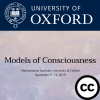Jonathan Mason - Expected Float Entropy Minimisation: A Relationship Content Theory of Consciousness
Jonathan Mason
Mathematical Institute, University of Oxford
Over recent decades several complementary mathematical theories of consciousness have been put forward including Karl Friston’s Free Energy Principle and Giulio Tononi’s Integrated Information Theory. In contrast to these, in this talk I present the theory of Expected Float Entropy minimisation (EFE minimisation) which is an attempt to explain how the brain defines the
content of consciousness up to relationship isomorphism and has been around since 2012. EFE involves a version of conditional Shannon Entropy parameterised by relationships. For systems with bias due to learning, such as various cortical regions, certain choices for the relationship parameters are isolated since giving much lower EFE values than others and, hence, the system defines relationships. It is proposed that, in the context of all these relationships, a brain state acquires meaning in the form of the relational content of the associated experience.
In its simplest form involving only “primary relationships” EFE minimisation can also be considered as a generalisation of the initial topology (i.e. weak topology). For us the family of functions involved are the typical (probable) system states, the common domain of these functions is the set of system nodes (e.g. neurons, tuples of neurons or larger structures) and the common codomain is the set of node states. In the case of the initial topology a topology is already assumed on the common codomain and the initial topology is then the coarsest topology on the common domain for which the functions are continuous. In our case no structure is assumed on either the domain or codomain. Instead EFE minimisation simultaneously finds structures (for us weighted graphs, but topologies could in principle be used) on both the domain and codomain such that the functions are close (in some suitable sense) to being continuous whilst avoiding trivial solutions (such as the two element trivial topology) for which arbitrary improbable functions (system states) would also be continuous. Thus we find the primary relational structures that the system itself defines. In this context objects (visual and auditory) are present and EFE then extends to secondary relationships between such objects by involving correlation for example. To aid application of the theory, computationally cheaper surrogates for EFE are being developed.
Filmed at the Models of Consciousness conference, University of Oxford, September 2019.




